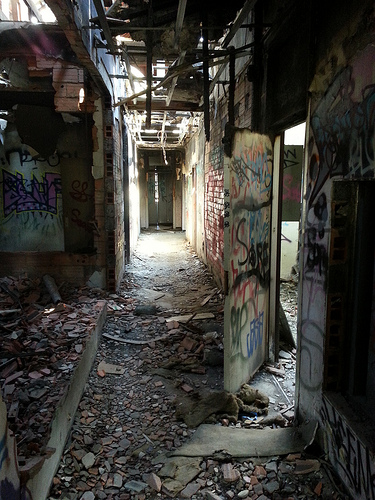I find myself searching for… something. Something to make me feel connected to this new place I’m in. Something to make Melbourne feel like mine.
So I do what I always do, when I’m seeking a connection, a way to feel the spark of other people’s lives.
Melbourne takes much better care of its abandoned buildings than Sydney does. Truly deserted structures are difficult to find here, and I haven’t seen enough of the suburbs to know where they are. Internet searches are lousy for that kind of thing- after all, revealing your locations publicly breaks the rules.
But the Brickworks stand out. A bit of online digging, and the address is easy enough to find.
It’s a half hour drive away, which is a short car trip by Sydney standards, an epic adventure for Melbournians spoiled by their unclogged roads and ample public transport. I sneak to the the Brickworks and back between school drop-off and pickup. It pleases me, this secret life I have sometimes. Stepping out of reality, doing things my children have no idea of and may not understand.
Like the Maltings, and other premises that are stalwarts for urban exploration, the Brickworks is easy to access. You just need to know what you’re looking for. The fence on one side is surrounded by homes, well tended and well kept. There will be no point of entry here.
The other side of the fence, however… look hard enough, and you find it. The mesh fencing bent up and over, leaving a hole big enough to squeeze through.
The parklands that surround the Brickworks are dotted with people who are out for the day. When trespassing, it’s best to act as though you have every right in the world to be there. My camera bag is slung over my shoulder, and I have my usual bullsh*t excuse ready. “I am a photographer, documenting this place…”
Not that anyone has ever asked. I like to think that it’s because I radiate self confidence. More likely, it’s because no one cares.
The Brickworks is, as the name suggests, a factory where bricks were made. It’s been closed for years, so long now that any evidence of it’s former functionality is gone. What remains is the evidence of people who have come here after its closure. Graffiti kits, empty spray paint cans. Litter. And a coating of fine, chalky brick dust, a few inches thick in some of the more undisturbed places.
Within minutes, my shoes and pants are covered in it. I’m dusty up to the knees of my flared jeans.
This is a gritty, grungy, post-apocalyptic scene of a place. The bright colours of the street art clash and spangle against rusted iron and rotted wood.
The machinery that has been left here is old and huge. Too cumbersome to have been moved on, probably useless for relocation And it’s all so set in itself– to remove the giant urns would be to defile the structure of the place completely, to risk having it all fall down on top of you. I can see why this abandoned site remains so, when the rest of Melbourne’s urban ruins have been cleaned up and cleared out. Just bulldozing it would be impossible. Tonnes of hulking steel equipment would be tedious to rip out. So it stays, looking more and more like iron oxide modern artwork with each passing year.
I pick around the place, wandering, marveling at the solidity of the equipment. One half of the building is open and cavernous, no more than undercover storage. A forklift is parked neatly by one of the poles toward the edge of the huge room. It seems put of place– too modern, perhaps, for somewhere that feels so antiquated. Not as rust eaten and grubby as its surrounds.
The forklift is tagged in jagged graffiti, a mish-mash of colours and styles. The surface of the forklift is too small for anything rampantly artistic, but the brick walls dividing the building into rooms and sections make the perfect canvases for spray painted art. Colourful cartoon creatures and shiny, six foot high typography cover the brick work.

I wander around, feeling the emptiness of the space, the way it’s hardly a building at all any more. It feels organic, settled in to its environment. Nature is beginning to spread itself within the building. Weeds take root in the base of the corroding steel. Grass grows where the sunshine allows it to.
Walking out of the main building, there’s a second structure. It’s large and circular and squat. The massive chimney soars skyward from the roof. There’s a strange flared skirt of corrugated iron covering the bottom of the building, stretching six foot up the meet the walls. It appears impenetrable. Despite all the people who have been here, left their rubbish and their tags and their spray paint cans, no one has peeled back the skirt and attempted the access the space underneath.
Two smaller outbuilding flank the main one, both of them damaged and spray painted. Door frames and windows smashed, floors are burnt out. The artwork is amazing. But there’s nothing to be felt here. It lacks the romance of the Maltings, the sense that lives have been lived here, the essence of souls left behind.
I leave, my feet padding softly through the brick dust. I find the hole in the fence that I first came through and slip back into reality, settle myself back amongst the people in the park.
I get back in my car. As I close the door, it begins to rain.
Whatever I was looking for, I didn’t find it.

{ 11 comments }

































